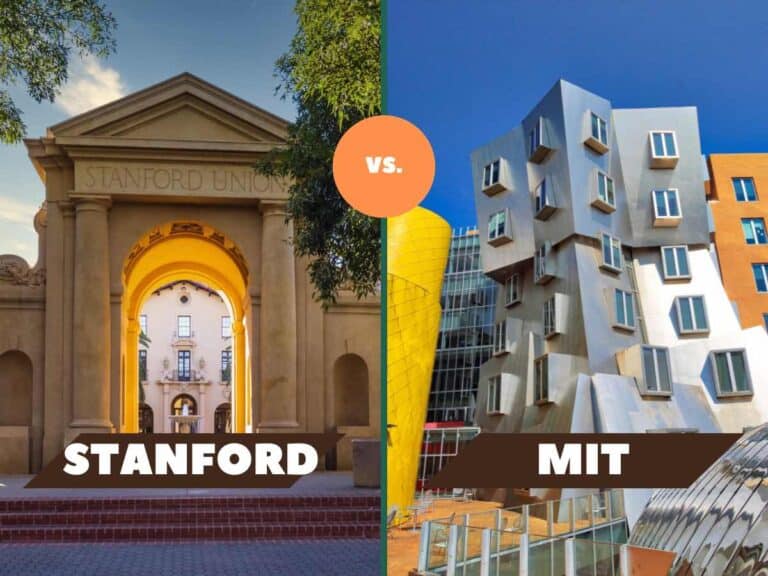Top 10 Traits That Stanford University Looks For
It may not be one of the nation’s eight Ivy Leagues, but it’s no secret that Stanford University is a prestigious school. It’s because of this why many college-bound kids plan to apply to it. You are thinking about following suit, but wondering if you are what Stanford is looking for exactly.
Stanford University is looking for students who can meet various academic and non-academic admissions factors. Some of the very important ones are GPA, standardized test score, class rank, admissions essay and letters of recommendation. Personal qualities and talents are considered, too.
Before you include this top-notch institution into your college list, read on!
We will talk about the various admissions factors used by the school’s admissions officers. By the time you reach the end of this article, you will have an idea of whether or not you should send an application to Stanford.

High GPA (4.0)
The Common Data Set for Stanford University makes it very clear that the GPA is a “very important” academic factor in the admissions decisions for incoming first-year students.
Because the school is comparable to the Ivy Leagues, it doesn’t come as a surprise why the majority of students admitted into it have high GPAs. As a matter of fact, as much as 68.7% of admitted freshmen for the academic year 2020 to 2021 had a perfect GPA of 4.0. On the other hand, 27.5% had a GPA ranging from 3.75 to 3.99.
Needless to say, you need to be at the top of your high school class if you want to become a Stanford student.
Refrain from assuming that you should no longer consider applying to Stanford University if your GPA is lower than 3.75. It is of utmost importance to note that the school has a holistic admissions policy. This means that many other things in the application are taken into account than just the GPA.
As a matter of fact, there were students welcomed into the campus with lower GPAs:
| GPA RANGE | PERCENTAGE OF ADMITS |
| 3.50 to 3.74 | 3.10% |
| 3.25 to 3.49 | 0.40% |
| 3.00 to 3.24 | 0.30% |
According to Stanford itself, the average GPA of all accepted first-year students is 3.96. Just in case yours is a little lower than this, make sure that the rest of your application can impress the school’s admissions officers.
Again, because Stanford University’s admission policy is holistic, your GPA is not the only admissions factor that matters.
Related Article: Getting Into Harvard With a 3.0 GPA
Class Rank in Top 10%
Stanford University is looking for applicants at the top of their high school class. Proof to this is the fact that class rank is a “very important” academic factor in the admissions decisions, says the school’s Common Data Set.
As much as 96% of freshmen students accepted into Stanford were in the top 10% of their high school graduating class. On the other hand, 3.2% of freshmen students the school admitted were in the top 25% of their high school graduating class. Only 0.8% of accepted freshmen students were in the top 50% of their high school graduating class.
However, it doesn’t mean that you are disadvantaged if your high school does not use class rank.
As a matter of fact, for the academic year 2020 to 2021, only 24.8% of admitted first-year students submitted their class rank. So, in other words, there is no need to think that your admissions chances are in peril just because class rank is something your high school doesn’t have — your GPA will reveal your class performance.
Just in case you are wondering if you have a good chance of getting accepted into Stanford University even without a class rank, you can use a variety of college chances calculators.

First-Generation Students
When checking out the various academic and non-academic factors used by Stanford University in deciding the fate of applicants, you will come across “first-generation”.
This means that, when assessing the entire application, the school’s admissions officers also take a look at whether or not the parents of the applicants have a bachelor’s degree. According to Stanford, for the class of 2023, up to 18.5% of the enrollees were first-generation students.
So, if your parents did not go to college and you’re the first one to do so in your family, it will be a role player in the admissions process, which means that it will impact your admissions chances.
But then again, since Stanford University has a holistic admissions policy, whether or not you are a first-generation student is just one of the many different things that will be considered.
Therefore, you may enjoy increased chances of getting accepted into the school if you are a first-generation with a strong overall application.
Legacy Students
Each year, Stanford University welcomes students whose families are already part of the institution’s history. Known as legacy students, they are accepted by the admissions officers together with new members of the school community in order to obtain a diverse class of students from all walks of life.
Above, we talked about the percentage of first-generation admits for the class of 2023.
The same source of that information says that up to 16.2% of the enrolling students were the kids of Stanford graduates.
On the other hand, 1.5% of the enrolling students had no legacy association with the school alright, but their application noted a history of philanthropy — their parents donated money or buildings to the prestigious school.
Related Article: Easiest and Hardest Ivy League Colleges to Get Into
Impressive Interview With Alum
Not everyone who applies to Stanford University gets invited for an interview. According to 2012 data, only about 10% of applicants were granted the interview option.
Fret not if you are not asked by the school for an interview. It doesn’t mean that your application is not as strong as the application of someone who is invited to spend a few minutes with an alumni member.
On the other hand, celebrate if you are asked for an interview.
That’s because it’s a wonderful opportunity for you to get to know more about Stanford and show, at the same time, you know the school more than everybody else as it’s your top choice. However, you should keep in mind that demonstrated interest is not a part of the admissions process.
Here’s what Stanford University says about turning down an interview:
“Declining an interview will not negatively impact your admission decision, and you may decline for any reason.”
The prestigious school adds that:
“Should you wish to decline an interview please communicate this to the interviewer rather than ignore the invitation. You do not need to share why you are declining an interview.”
While it’s clear that declining an interview will not lower your admissions chances, doing badly in the interview may impact the decisions of the admissions officers. This is especially true if you make it obvious that Stanford is just your backup school or you did not research the institution enough because you are not that interested in attending it.

Ponder on this before proceeding to the next topic:
According to Stanford University’s Common Data Set for the academic year 2020 to 2021 itself, the interview is “considered” in the admissions process for incoming first-year students.
Extraordinary Extracurriculars aka Spike
Speaking of the admissions factors based on the school’s Common Data Set, extracurricular activities are deemed “very important” by the admissions officers at Stanford University.
In other words, ECs are on the same level as other “very important” factors like GPA and class rank.
Like many colleges and universities, including some of the most prominent on the land, Stanford has a holistic admissions policy.
That’s because it’s aware of the fact that admitting students based on academics alone would make for a particularly boring community. And this is why non-academic factors are deemed important, too.
Sitting proudly at the top of the list of non-academic factors taken into account in the admissions process for incoming first-year students is the list of extracurricular activities.
Just because you want to impress doesn’t mean you should have a five-page listing of ECs.
Here’s where Stanford University stands when it comes to extracurriculars:
“… An exceptional depth of experience in one or two activities may demonstrate your passion more than minimal participation in five or six clubs. You may also hold down a job or have family responsibilities. These are as important as any other extracurricular activity.”
Basically, the school wants to have an idea of the impact you have had in your family, school or community.
Stanford itself says that there are instances in which exceptional athletic abilities may influence admissions chances if the applicant is otherwise qualified. However, being good at sports alone never guarantees acceptance.
Related Article: Is Volunteering an Extracurricular Activity?
Engaging Essays
Unlike an interview and extracurricular activities, the application essay is considered an academic factor in the admissions decisions. More importantly, it is deemed “very important” by Stanford University.
It’s exactly because of this why you should make sure your essay is a well-written piece.
But composing one winning essay when applying to Stanford is not enough. If you want to impress to increase your chances of receiving an offer from the high-status institution, you need to write and submit not one, not two, not three but a total of four essays to the school’s admissions officers:
- One Common App or Coalition App personal essay
- Three short essays
So, how short are the essays Stanford requires applicants to write besides the Common App or Coalition App essay? Each one should have a minimum of 100 words and not more than 250 words.
The following are the short essay questions:
- The Stanford community is deeply curious and driven to learn in and out of the classroom. Reflect on an idea or experience that makes you genuinely excited about learning.
- Virtually all of Stanford’s undergraduates live on campus. Write a note to your future roommate that reveals something about you or that will help your roommate — and us — get to know you better.
- Tell us about something that is meaningful to you and why.
If you think that it ends there, better think again! Besides the Common App or Coalition App personal essay and the three short essays, Stanford University also requires applicants to answer several short questions. Each answer is so short that you will have to stay within the 50-word limit.
Some examples of the questions applicants have to answer are:
- Briefly elaborate on one of your extracurricular activities or work or family responsibilities.
- What is the most significant challenge that society faces today?
- How did you spend your last two summers?
- What historical moment or event do you wish you could have witnessed?
- What five words best describe you?
- When the choice is yours, what do you read, listen to, or watch?
- Name one thing you are looking forward to experiencing at Stanford.
- Imagine you had an extra hour in the day — how would you spend that time?

Recommendation Letters From 2 Teachers
Most colleges and universities ask applicants to submit just one recommendation letter. And usually, too, it should be written by the high school counselor. Well, it’s a different thing for Stanford University. That’s because you will have to submit two recommendation letters, and both of them have to come from two teachers of yours.
It’s a good idea to pick a teacher who knows you so well so that your strengths can be highlighted.
However, Stanford recommends requesting recommendation letters from your junior or senior high school teacher, preferably those who teach any of the following:
- English
- Math
- Science
- Foreign language
- History
- Social studies
The admissions officers at Stanford add that it’s perfectly fine to ask a sophomore high school teacher to write your recommendation letter if he or she teaches advanced coursework, such as an AP, IB or Honors class. Doing so will help ensure that your college readiness will be the core of your recommendation letter.
Besides the two recommendation letters from two of your teachers, you may also submit one optional recommendation letter written by a person who knows you well and can provide new and fundamental insight about you. To make sure that the additional essay will reach Stanford University’s admissions office:
- Assign the person as the “Other Recommender” when using the Common App.
- Add a “General Recommendation” when using the Coalition App.
Outstanding Test Scores
Before anything else, let’s get one thing clear: As of this writing, Stanford University, like thousands of other US colleges and universities, is a test-optional school.
So, in other words, when applying to it, you may or may not provide your standardized test score. It doesn’t matter if you are not happy with it or were unable to take the SAT or ACT.
However, Stanford can go back to requiring test scores at any time it wants.
This is when the importance of preparing for the SAT or ACT very well to get a good score comes in. Just in case the school asks applicants to submit their standardized test scores all of a sudden, there is no need for you to panic.
Just like the GPA, your standardized test score is a “very important” academic factor in the admissions process for Stanford University. Needless to say, your SAT or ACT score can spell the difference between getting accepted into the school or getting a rejection letter from its admissions office.
To increase your admissions chances, your SAT score should be anywhere between 1420 and 1550. On the other hand, your ACT score should be between 1400 and 1600.
Stanford is great, you will find your own community and your place since it’s a very large school. Admin really encourages students to explore their own paths, think deeply about the most relevant problems in today’s society, and be educated as a global citizen.
Niche.com
However, it doesn’t mean that you should lose hope if your standardized test score is below the range mentioned above. For instance, 18.9% of students admitted for the academic year 2020 to 2021 had SAT scores between 1200 and 1399. There were also very few admits (1.6%) who had SAT scores between 1000 and 1199.
So, should you submit your test score even if Stanford is currently a test-optional school?
Providing your SAT or ACT score when applying to the school is a great idea. This is especially true if it’s high enough to help increase your admissions chances.
Despite knowing that Stanford University has a test-optional admissions policy, 71.9% of admits submitted their SAT scores, and 45.0% of admits submitted their ACT scores.
If you are looking for test blind schools, check the review of UC Berkeley.
Unique Character/Personal Qualities
Every college-bound student is unique. But since Stanford University is a prestigious and selective school, the majority of the applications it receives every college application season are from some of the brightest students.
Based on Stanford’s Common Data Set for the academic year 2020 to 2021, a total of 6,366 undergraduate students were admitted. Let’s say that the school is still in the process of admitting students and there is only one slot remaining, and you and another applicant are equally worthy of it because your academic and non-academic factors are the same.
As an institution, Stanford offers the best resources and opportunities. You can accomplish your craziest dreams: From creating a start-up, publishing a book, traveling, the school will help you with it. However, there is still poor support for the well-being of students (Mental health resources, sexual assault prevention, etc)
Niche.com
This is when the admissions officers at Stanford will consider unique circumstances.
Background, educational pathway, family responsibilities — these are just some of the things that will be considered in order to put your achievements into context. These factors that can set you apart from other applicants will be taken into account as part of the school’s holistic admissions policy.
It’s exactly because of this why, if you check out the Common Data Set for Stanford University, you will notice that the non-academic admissions factor “character/personal qualities” is considered “very important”.
Above, we talked about the different admissions factors used by Stanford University’s admissions officers.
With a very low acceptance rate of 4.3%, you can rest assured that not everyone who applies to Stanford gets accepted. The good news is that you can increase your admissions chances by meeting most, if not all, of the things that the elite institution is looking for in applicants.
Read Next: 17 Best Colleges on the West Coast: West Ivies
Disclaimer: The views and opinions expressed in this article are those of the authors and do not necessarily represent those of the College Reality Check.





